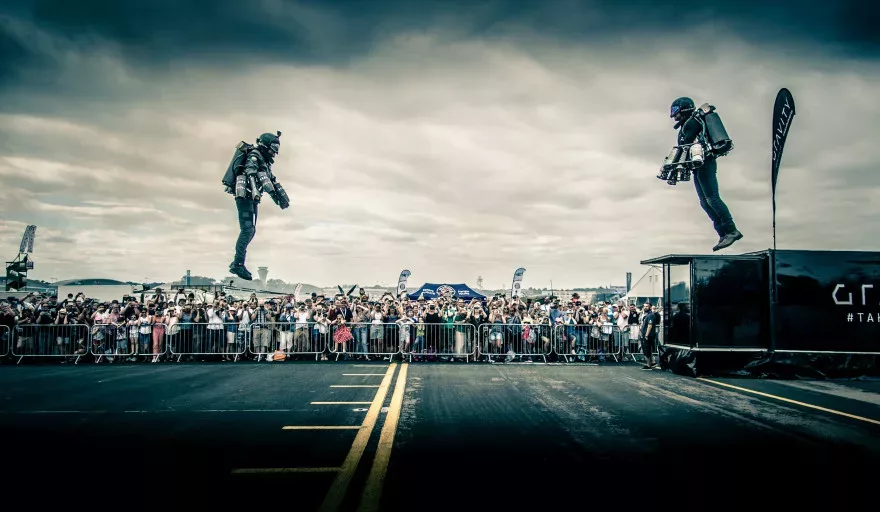The ‘Iron Man’ suit of Richard Browning has thrilled crowds and wowed the social media stratosphere since it launched in April 2017. He tells us the story behind monetising an idea into Gravity Industries.
INTRODUCTION
“Actually, in and around that TED event, I stopped off in San Francisco and did a flight demo for the Drapers, who I didn’t realise at the time were one of the biggest VC families in the valley. They offered me a $640,000 deal in the car park. That was my one and only VC round, and since then we have been able to generate our own capital.”
You would be forgiven for thinking that Richard Browning was involved in a mafia-style exchange in the summer of 2017.
An extraordinary amount of money to receive in a parking lot, the inventor and entrepreneur knew he was onto a winner when he wowed such a formidable venture capitalist to this extent. And it is little surprise given what the demonstration was – a flight in a real-life ‘Iron Man’ suit.
Its proper name is the Gravity Jet Suit, Browning having successfully converted an idea and prototype into a fully functioning business named Gravity Industries.
Making its money by touring the world with public demonstrations, holding private training sessions and conducting work with military clients, the company is now fully standing (or flying) on its on two feet, the Founder and CEO citing this as arguably a greater challenge than developing the extraordinary product in the first place.
But where and how did it all begin? Considering Browning’s family heritage and working background, the fact he created a jet-propelled flying suit is perhaps less surprising than you might think.
“I was an oil trader with BP for 16 years, and spent six years with the Royal Marines in parallel with that,” he recalls. “My whole family background centres around aeronautics and aviation – one grandfather used to be a civil and wartime pilot, and the other ran a helicopter firm. My late father was an aeronautical engineer and kind of maverick inventor of his own.
“I had a challenging time during childhood. My father died when I was 15, and that provided the determination for me to build a secure foundation for myself. While I worked for BP, I was involved in a lot of enterprising work and have always had a passion for building and breaking things apart. I was always ready to go where others hadn’t, and soak up failure after failure, if it meant eventually arriving at something that hadn’t been done before.
“So, in a way, I amalgamated my family background and a passion for human capability that the Marines taught me. There was a lot of calisthenics training, so I had this idea that you could probably support your own bodyweight via a momentary form of propulsion, a way of getting off the ground that people seemingly didn’t think was possible.”
This prompted Browning to, in his words, “mess around with existing pieces of equipment” to test the concept towards the end of 2016, the starting point of the Gravity journey.
Such was the entrepreneur’s concern that the idea may not lead into a viable earner for the rest of his career, he managed to keep ties with BP for another two years, a safety net which gave him the confidence to go full throttle and turn the concept into a reality.
Evenings and weekends were spent experimenting until the trigger was pulled with the launch of Gravity in April 2017, Browning immediately receiving interest and invites to various events.
THE TECHNICAL CHALLENGE
“From a technical point of view, the biggest challenge was incorporating thrust to the human brain and body to create elegance in the movement.
“Take a bicycle. If you have never seen one before, you would think what on earth is this, and probably fall on the floor trying to make it work.
“However, look at the elegance of a bicycle when it is married up with the human brain and body. My idea was to create a sort of aeronautical bicycle in a way. It is a wonderful feeling being in control, so this is what I wanted to make, rather than a machine that simply flies you to a postcode.”
“BP knew everything I was doing and loved it,” he says. “I had a history of enacting some pretty wacky R&D there during my time, especially around how commodity trading was conducted globally by doing something with cargo tracking, which is now very much mainstream. I stumbled across it in a similar sort of vein to Gravity.
“I held on at BP for another six months and then took a career break, leaving the backdoor open in case I needed to come back in. It’s one thing developing this on the fly – it’s entirely another thing to turn it into a viable business. That, arguably, has been a harder challenge than developing the idea. It is actually one of the proudest parts of this story for me.”
With the help of a business partner in the media and entertainment sphere, the Gravity brand was born.
A first major breakthrough came with Red Bull, the stunt-friendly company co-producing some promotional videos which helped to catapult the company into the public eye.
Events such as TED quickly followed, the demand for demos and private training sessions snowballing alongside the traction being gained via social media platforms, especially YouTube and Instagram.
“We’ve done 103 events in 30 countries so far – it’s absolutely fantastic for me and our seven pilots to be paid to travel and fly in front of people,” Browning adds. “We also earn good money in California and the UK carrying out client training programmes. They have really good fun coming over to us and learning how to fly, and you can do it in a couple of days.”
It hasn’t all been plain sailing, however. For a company so reliant on thrilling crowds, the impact of coronavirus has been particularly disruptive. Gravity was due to launch an inaugural flying race series in Bermuda in March, its postponement being a huge disappointment to Browning, who firmly believes it can build a Formula One style platform around the world.
But that time will arrive, the priority for Gravity at the moment being to continue building up its profile by pushing out the reems of video content it has all over social media.
The conversation soon turns to the endgame for the Iron Man suit. Although the company has sold a couple of units, ramping up production and making it mainstream is not on Browning’s radar.
“I’d say we operate more like the model of a high-end Ferrari, where they only let you drive it round a track before putting it back in the box again,” he explains.
“This is similar. While it is not especially difficult to fly one of our suits, if you let your foot slip on the throttle then you’re potentially flying at 150 miles per hour into a wall. I didn’t set the company up to do that – I want people to be safe, happy and have fun.”
And Gravity isn’t also about to revolutionise the realm of public transport either, not with the suit in its current form at least.
Browning continues: “In terms of a mainstream form of transport, it is noisy, potentially very dangerous and not the most fuel-efficient way of getting around, but then again, the first motor cars were thought about in that way versus a horse.
“My stance on it is to have massive fun trying to inspire people, especially younger generations, from a STEM point of view in the form of a race series. That is an amazing vehicle with which to develop the technology. If we have a huge breakthrough with energy storage and batteries, for instance, why can’t we go electric? That then opens up the conversation about becoming a bit more mainstream.
“However, I am not going to stand on a stage and announce that I am about to transform public transport! Mind you, we do get people messaging us saying how they want to fly to work to avoid congestion.”
And what of the Gravity Jet Suit’s military potential? By Browning’s own admission, this is much more of an experimental stream of business, but one which has yielded far more progress than he ever imagined to date, and certainly one to watch in the future.
He explains, in layman’s terms, why.
“This will make more sense to people involved in tactical military operations than somebody who has watched Saving Private Ryan.
“People immediately think it is noisy and you can’t use your hands, so how can it be useful? However, there is a pretty simplistic rebuttal in that wars are not quiet, and when you are moving you are not firing. So, with that in mind, what are you trying to do?
“Being able to move from one position to another or around obstacles like minefields and rivers, at speed, is all of sudden a very useful capability to have. It can also serve extraction purposes, taking away the need to fly a helicopter into dangerous areas.”
The experimental work will no doubt continue, and as 2020 draws to a close, Browning is fervently optimistic about what next year will bring, especially if the race series is able to take off.
For the time being, however, it is all about awareness. I end the conversation with a question that easily could have started it – simply, what does it feel like to fly the suit?
Browning answers: “The feeling is like nothing else. It’s dreamy. There is no gravity and you can be completely free to go where you want. I remember doing a flight in Prague and flying past a duck in the air above the river – I turned round and chased after it. I cannot really explain how it felt to be flying alongside a bird at 40 miles per hour. It’s ludicrous, entirely epic.”































